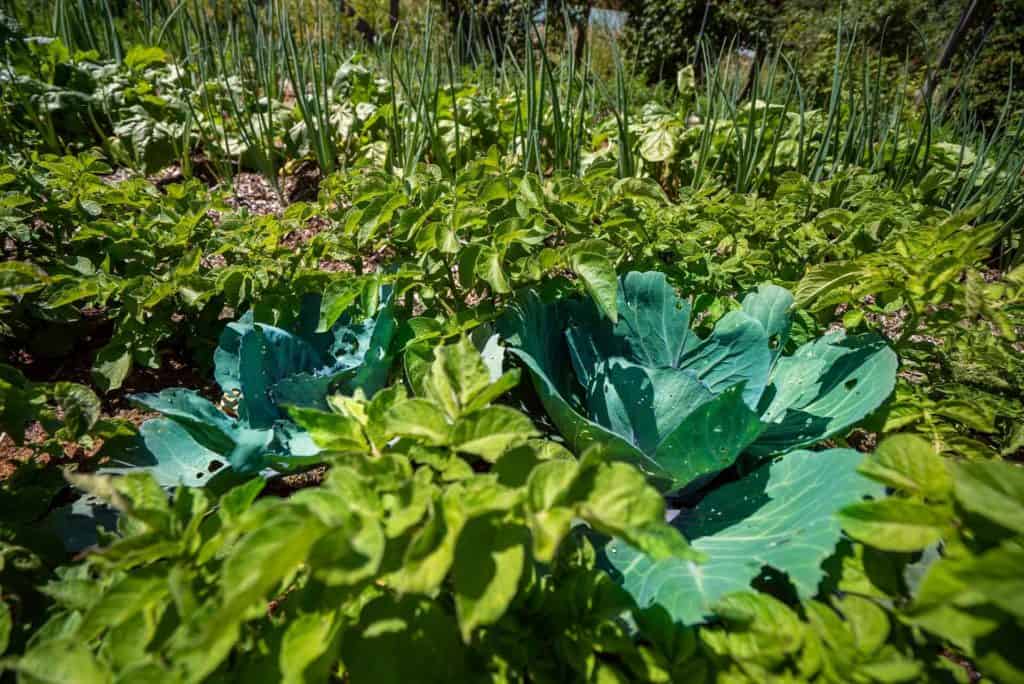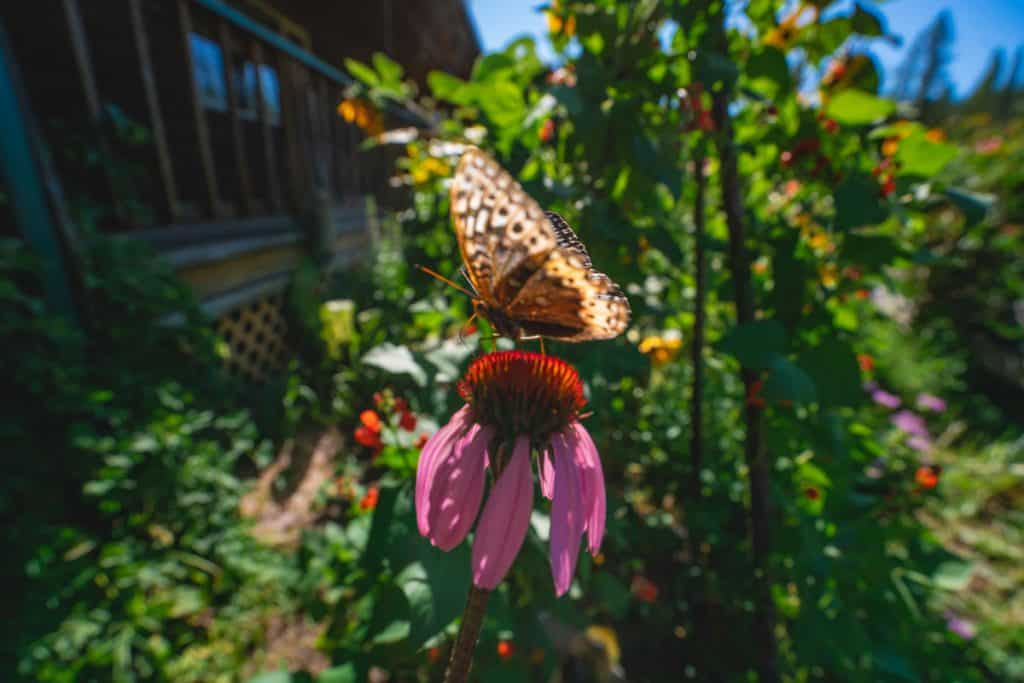
When planning a spring garden, you may ask, “Should you plant tomatoes with potatoes? Can onions and squash be planted near each other? What herbs are beneficial to plant near peppers in the vegetable garden?”
Companion planting in your garden is most practical when you have a good guideline or chart to follow. Read on to learn why and how.

What Is Companion Planting
Companion planting is a great way to incorporate permaculture design. We use this method when designing a cottage garden to bring together cohesiveness between plants, flowers and herbs as nature intended.
We have adopted the basic principles and design of permaculture as our agricultural system and learned how to organize our property’s permaculture zones to incorporate the management of humans, plants, surrounding habitat and animals.
We are so passionate about this system that we decided to offer a class on permaculture to help others integrate the permaculture design on their homestead. This crash course teaches you the basics of permaculture and how to implement it into your life.

What Is a Companion Planting Example
The Three Sisters Method has roots connected to Native American culture and is probably the most recognizable example of companion planting. The method involves planting three vegetables (corn, beans and squash) as companions in mounds of soil.
The corn is sewn first, and after sprouting, bean seeds are sewn into the soil around the corn, enriching it with nitrogen, and the corn stalks become the bean’s trellis. Lastly, squash is planted between the mounds and shades the ground keeping in the moisture for all three plants.
Even at the dinner table, you eat carbs from the corn, protein from the beans, and vital nutrients and fiber from the squash. The Three Sisters companion planting method has been around for over 500 years and has been adopted by many cultures.
Marigolds, basil and tomatoes planted near each other also provide a beneficial trio. Tomatoes benefit from the marigolds’ incredible power to repel white flies. Basil can attract pollinating insects while it repels hornworms, aphids and spider mites.
An added benefit is that tomatoes can absorb the basil’s flavor, enhancing some of my signature recipes like fermented tomatoes, fermented ketchup, and raw marinara sauce to use on homemade pasta or pizza pepper poppers.

Benefits of Companion Planting
Companion planting adds beauty to the garden, increases sustainability, and promotes healthier and more productive plants. Gardening for serious food production can be a lot of work, but companion planting helps make the job easier and more efficient.
When using the beneficial pairing of various plants, they will balance the pH level of the soil, prevent pests and disease, keep weeds out of the garden, attract pollinators, support successful garden watering strategies, and provide shade or sun where needed so each plant thrives the best way it can.

What Plants Should Not Be Planted Together
While certain plants benefit each other, you should also know that certain plants will work against each other. You can find more common gardening mistakes to avoid here.
- Asparagus – Asparagus needs space to grow. Planting garlic, onions and potatoes next to asparagus will compete for that space, stunting its growth.
- Beans – Beans (pole and bush) don’t do well with the allium family (onions, garlic, leeks, chives, etc.) Alliums kill the beneficial bacteria that grow on the roots of bean plants and will stunt their growth.
- Brassicas (Broccoli, Brussels Sprouts, Cabbage, Cauliflower, Kale, etc.) – You should not plant brassica varieties with tomatoes, beans (pole and runner) and peppers, as they attract pests that are harmful to them. Brussels sprouts also require a long growing season and need room to grow. Tomatoes, strawberries and potatoes compete for the soil’s nutrients and should not be planted near Brussels sprouts.
- Carrots – You should not plant parsnips, fennel, strawberries and cabbage plants with carrots because they attract the same pests and diseases, leaving your garden open to maximizing an infestation.
- Corn – Corn should not be planted with tomatoes, brassicas and celery. These plants are heavy feeders and compete for soil nutrients. Tall corn will shade these plants and need as much sun as possible.
- Lettuce – Lettuce should not be planted with brassicas varieties, celery or parsley. Brassicas inhibit root growth, celery attracts similar insects, and parsley can cause lettuce to bolt.
- Peas – Peas should not be planted with garlic, onions, potatoes, and beans. These plants are heavy feeders, and the peas can’t compete for the nutrients and grow well.
- Peppers – Pepper varieties should not be planted with beans or any brassicas. They are heavy feeders and will compete with the peppers for soil nutrients.
- Potatoes – Potatoes are not good companions with tomatoes, cucumbers, squash, melons, pumpkins and sunflowers. These plants are heavy feeders depleting the soil of vital nutrients and much-needed space that the potatoes need for their long growing season. (Use this guide to learn when to harvest potatoes.)
- Tomatoes – Tomato plants should not be planted near brassicas, potatoes or corn. Tomato fruit worms, corn earworms, and potato blight can become problematic for these plants as companions.

What Plants Should Be Planted Together
Whether you have a small vertical container garden or plan to grow a year’s worth of food, you will benefit from grouping these plants.
- Asparagus – Asparagus shares its space well with strawberries. Strawberries have a shallow root system that will not compete with asparagus’ need for room to grow. Tomatoes, basil and parsley all repel asparagus beetles, protecting the asparagus.
- Basil – Basil is compatible with most vegetables in the garden, especially tomatoes. Great for repelling the asparagus beetle, aphids, spider mites, hornworms, and mosquitos.
- Beans – Bush beans and pole beans fix nitrogen in the soil, which will benefit squash, cucumbers, tomatoes, corn, cabbage, carrots, beets, strawberries, Swiss chard, lettuce and spinach.
- Brassicas (Broccoli, Brussels Sprouts, Cabbage, Cauliflower, Kale, etc.) – The root systems of brassicas, spinach, and potatoes grow on different levels, making them good neighbors for each other. Since legumes fix nitrogen, brassicas can benefit from areas beans grew in past seasons. Additionally, onions repel brassica-loving pests.
- Carrots – The root systems of carrots, lettuce and spinach grow on different levels, making them good neighbors for each other. Radishes help break up the soil for carrots to spread and grow, tomatoes provide the right amount of shade carrots need, and onion helps deter the carrot fly.
- Corn – Corn prefers to be near beans, squash, bush or pole beans (Three Sisters Method), as do cucumbers and melons. These climbing plants will use the corn stalk as a trellis.
- Garlic – The smell of garlic repels common pests to cabbage and tomato plants, and garlic can help prevent fungal overgrowth on pepper plants. Growing garlic can also repel Japanese beetles when planted near blueberries and raspberries.
- Lettuce – Onions and radishes work well to repel and deter pests away from your lettuce crop, and lettuce planted near radishes has been known to produce more tender radishes. Beans and peas will work to give lettuce a needed nitrogen boost, and carrots grow deeper than the lettuce’s shallow root system, so the two won’t compete for space and nutrients.
- Onions – The strong smell of onions keeps common pests to beets, carrots, and tomatoes at bay. The root systems of onions and spinach grow on different levels, making them good neighbors, and lettuce can help keep weeding down when planted around onions.
- Peas – Like beans, peas add nitrogen to the soil, benefiting carrots, turnips, spinach, lettuce, radishes, and corn.
- Peppers – Peppers, tomatoes, and eggplant all have similar soil needs. As long as they are spaced appropriately, they should cohabitate well together. The root systems of peppers, onions and beets grow on different levels, making them good neighbors too.
- Potatoes – Beans and peas provide much-needed nitrogen for potatoes, and the shallow root systems of cabbage and corn allow potatoes to develop without competing for nutrients.
- Tomatoes – You should plant tomatoes with herbs such as basil, parsley, and oregano (borages). They will pick up the flavor of the herb and enhance its flavor. Tomatoes can provide shade for heat-sensitive carrots, and onions can help repel tomato-loving pests. Additionally, cucumbers and tomatoes have similar soil needs, so as long as they are spaced appropriately, they should cohabitate well together.
Homesteading Hack: Besides combining your vegetable crops, growing medicinal herbs and flowers also provides benefits.
Marigolds are among the most popular flowers to attract beneficial insects and repel flea beetles and cabbage moths. Calendula repels tomato worms and other insects, comfrey accumulates nutrients, and yarrow can repel soil nematodes, bean beetles and aphids.

Clyde’s Garden Planner
Clyde’s Garden Planner is one of our favorite gardening tools to keep handy.
This handheld planner is a great reference for recommendations on when to plant and harvest according to your frost dates, planting in hills or rows, spacing between plants, a companion planting chart and more.
To get 10% off your order, and so they know we sent you, use code “homesteadingfamily.com” at the checkout!
Many charts and guidelines are out there to help you with even more companion planting options.
Just make sure you are familiar with your zone and your last frost date. Talk with your neighbors who have been gardening in your area, as they will be a wealth of information, and reaching out builds community, which is a cornerstone in increasing self-sufficiency.

Other Articles You May Enjoy
- Permaculture Design for the Homestead
- The Benefits of Container Gardening
- Organizing your Property’s Permaculture Zones
- Designing an Old-Fashioned Cottage Garden
- Gardening for Serious Food Production
- Attracting Pollinators
- How to Grow Chives (Plant, Harvest, Preserve)
- Growing Calendula Flowers (Plant, Harvest, Preserve)
- Keeping Weeds Out of the Garden
- Garden Watering Strategies
- 10 Common Gardening Mistakes to Avoid
















